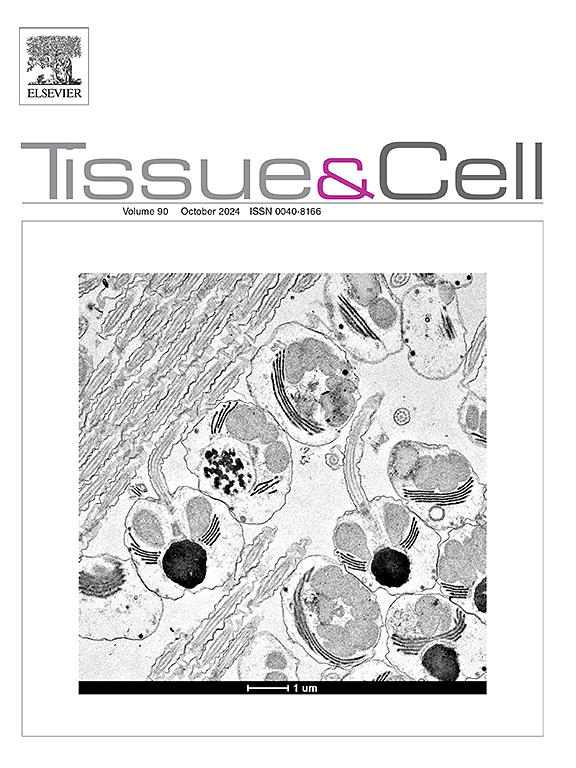Biological aspect of the jaw system of meagre (Argyrosomus regius): New insights into jaw teeth distribution, characterization, and their relationship to its carnivorous behaviour
IF 2.7
4区 生物学
Q1 ANATOMY & MORPHOLOGY
引用次数: 0
Abstract
Documentation on the morphological appearance of teeth and their relationship to carnivorous feeding habits was lacking. Our study was applied to twelve Argyrosomus regius using the gross scanning electron microscopic techniques to provide a detailed ultrastructural description of the jaw, its tooth arrangement, and the relationship to carnivorous feeding behavior, which had not been previously described. The upper velum's oral surface contained only taste buds. There were two teeth in the upper caudal premaxillary fangs and four in the lower. Two premaxillary teeth groups were identified: the median upper of 3–4 rows and the median lower of 4–5 rows. The lateral upper incisive group had numerous small teeth (in 3–4 rows) and the long ones in one row, while the lateral lower one was organized in two rows: large posterior and small anterior. The dental arrangement in the lateral upper premaxillary group is highly specialized, with numerous small teeth in three or four rows and long teeth in one row. In contrast, the lateral lower group exhibited a different pattern, with small, short, straight teeth arranged in groups parallel to the dental space. The upper lateral tooth band had two types: the medial lower one of long teeth, while the medial upper one of small, short teeth in four or five rows, except anteriorly in just two rows. Conclusion, the arrangement and size of teeth in fish's upper and lower jaws can reveal their diet and feeding habits, and studying tooth morphology can aid researchers in understanding their evolutionary adaptations.
巨蝮下颚系统的生物学方面:对下颌牙齿分布、特征及其与食肉行为关系的新认识
关于牙齿的形态和它们与食肉动物食性的关系的文献资料缺乏。本研究利用扫描电镜技术,对12只大鲵的下颌、牙齿排列以及与食肉性摄食行为的关系进行了详细的超微结构描述。上膜的口腔表面只有味蕾。上颌前尖牙尾部上部有两颗牙齿,下颚有四颗牙齿。确定两组前颌牙:3-4排中上颌牙和4-5排中下颌牙。侧上切牙群小齿多排(3-4列),长齿多排,侧下切牙群后大前小两排。上颌前侧组的牙齿排列是高度特化的,有许多小牙齿排成三排或四排,长牙齿排成一排。相比之下,侧下组表现出不同的模式,小、短、直的牙齿与牙间隙平行排列。上侧齿带有两种类型:中下齿带是长牙齿,中上齿带是小而短的牙齿,排列在四到五排,前面只有两排。结论:鱼类上下颌牙齿的排列和大小可以揭示鱼类的饮食和摄食习惯,研究牙齿形态有助于了解鱼类的进化适应。
本文章由计算机程序翻译,如有差异,请以英文原文为准。
求助全文
约1分钟内获得全文
求助全文
来源期刊

Tissue & cell
医学-解剖学与形态学
CiteScore
3.90
自引率
0.00%
发文量
234
期刊介绍:
Tissue and Cell is devoted to original research on the organization of cells, subcellular and extracellular components at all levels, including the grouping and interrelations of cells in tissues and organs. The journal encourages submission of ultrastructural studies that provide novel insights into structure, function and physiology of cells and tissues, in health and disease. Bioengineering and stem cells studies focused on the description of morphological and/or histological data are also welcomed.
Studies investigating the effect of compounds and/or substances on structure of cells and tissues are generally outside the scope of this journal. For consideration, studies should contain a clear rationale on the use of (a) given substance(s), have a compelling morphological and structural focus and present novel incremental findings from previous literature.
 求助内容:
求助内容: 应助结果提醒方式:
应助结果提醒方式:


